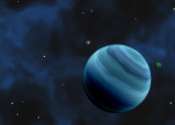New exoplanet is smallest to be precisely measured
Earthlings have long daydreamed about faraway planets, but only recently have scientists been able to identify thousands of new exoplanets—and to learn more and more about what they look like.

Earthlings have long daydreamed about faraway planets, but only recently have scientists been able to identify thousands of new exoplanets—and to learn more and more about what they look like.
Astronomy
Jul 31, 2019
2
212

The Kepler mission and its extension, called K2, discovered thousands of exoplanets. It detected them using the transit technique, measuring the dip in light intensity whenever an orbiting planet moved across the face of ...
Astronomy
Jun 24, 2019
0
0

Astronomers at The University of Texas at Austin, in partnership with Google, have used artificial intelligence (AI) to uncover two more hidden planets in the Kepler space telescope archive. The technique shows promise for ...
Astronomy
Mar 26, 2019
0
531

An international team of astronomers, led by University of Hawaiʻi graduate student Ashley Chontos, announced the confirmation of the first exoplanet candidate identified by NASA's Kepler Mission. The result was presented ...
Astronomy
Mar 5, 2019
0
693

Using data from NASA's Kepler space telescope, citizen scientists have discovered a planet roughly twice the size of Earth located within its star's habitable zone, the range of orbital distances where liquid water may exist ...
Astronomy
Jan 9, 2019
1
576

They say there's more than one way to skin an interstellar cat, and in astronomy there's more than one way to find alien exoplanets orbiting a distant star. With the recent shut-down of NASA's prolific Kepler mission and ...
Astronomy
Nov 21, 2018
0
12

The Kepler spacecraft launched in 2009 with the goal of finding exoplanets orbiting distant stars. In the years since, astronomers have used Kepler observations to discover 2,818 exoplanets as well as another 2,679 exoplanet ...
Astronomy
Nov 2, 2018
1
811

After nine years in deep space collecting data that indicate our sky to be filled with billions of hidden planets—more planets even than stars—NASA's Kepler space telescope has run out of fuel needed for further science ...
Astronomy
Oct 31, 2018
0
13

We've all heard about the search for life on other planets, but what about looking on other moons?
Astronomy
Jun 14, 2018
3
1156

When thinking about Earth-like exoplanet discoveries, the Kepler space telescope immediately comes to mind. Yet, it is not only Kepler, but also ground-based information from the HARPS-N spectrograph, that allowed the ETAEARTH ...
Astronomy
May 29, 2018
0
37